Flag of Lebanon
 | |
| Use | National flag and ensign |
|---|---|
| Proportion | 2:3 |
| Adopted | December 7, 1995 |
| Design | A horizontal triband of red, white (double height) and red; charged with a green Lebanon Cedar. |
The flag of Lebanon (Arabic: علم لبنان) is formed of two horizontal red stripes enveloping a horizontal white stripe. The white stripe is to be two times a red one (ratio 1:2:1)—a Spanish fess. The green cedar (Lebanon Cedar) in the middle touches each of the red stripes and its width is one third of the width of the flag.[1]
Symbolism
Presence and position of the Cedar in the middle of the flag is directly inspired by the mountains of Lebanon cedar (Cedrus libani). The Cedar is a symbol of holiness, eternity and peace. As an emblem of longevity, the cedar of Lebanon has its origin in many biblical references.

The cedar of Lebanon is mentioned seventy-seven times in the Bible, especially in the book Psalms chapter 92 verse 12 where it says that "The righteous shall flourish like the palm tree, He shall grow like a cedar in Lebanon"[2] and Chapter 104, verse 16, where it is stated: "[t]he trees of the Lord are well watered, the cedars of Lebanon that he planted".[3]
Alphonse de Lamartine (1790-1869), marveling at the cedars of Lebanon during his trip to the Orient with his daughter Julia, had these words: "[t]he cedars of Lebanon are the relics of centuries and nature, the most famous natural landmarks in the universe. They know the history of the earth, better than the story itself".[4]
Antoine de Saint-Exupéry (1900-1944), who loved the cedars and also had visited Lebanon in 1935, wrote in his work Citadel "[t]he peace is a long growing tree. We need, as the cedar, to rock its unity".[5]
For the Lebanese, the cedar is a symbol of hope, freedom and memory. In 1920, in a text of the proclamation of the State of Greater Lebanon, it was said: "[a]n evergreen cedar is like a young nation despite a cruel past. Although oppressed, never conquered, the cedar is its rallying. By the union, it will break all attacks".[5]
The white color on the flag represents the snow as a symbol of purity and peace.
The two red stripes refer to the Lebanese blood shed to preserve the country against the successive invaders.
Construction sheet

According to the Article 5 of the constitution of Lebanon: "The Lebanese flag shall be composed of three horizontal stripes, a white stripe between two red ones. The width of the white stripe shall be equal to that of both red stripes. In the center of and occupying one-third of the white stripe is a green cedar tree with its top touching the upper red strip and its base touching the lower red stripe".[6]
History
Ancient flags of Lebanon
 Flag used during Phoenician era 3000 BC – 200 AD (Including the currently known as Cyprus, Syria, Israel, Tunisia and Lebanon)[7]
Flag used during Phoenician era 3000 BC – 200 AD (Including the currently known as Cyprus, Syria, Israel, Tunisia and Lebanon)[7] Tanukh Flag 200 AD – 400 AD[7]
Tanukh Flag 200 AD – 400 AD[7].svg.png) Flag under the Abbasid Caliphate 750–1258
Flag under the Abbasid Caliphate 750–1258 Kingdom of Jerusalem Flag 1099–1291
Kingdom of Jerusalem Flag 1099–1291
Flags of clans during the Middle Ages
 Feudal Flag of the Jumblat clan during Middle Ages
Feudal Flag of the Jumblat clan during Middle Ages Feudal Flag of the Abu Kanad clan during Middle Ages
Feudal Flag of the Abu Kanad clan during Middle Ages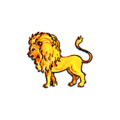 Feudal Flag of the Lamaite princes during Middle Ages
Feudal Flag of the Lamaite princes during Middle Ages
Flags of sultanates and emirates
 Flag of the Maanid Emirate 1119–1697
Flag of the Maanid Emirate 1119–1697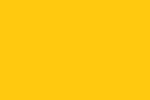 Flag under the Ayyubid Dynasty pre-1250
Flag under the Ayyubid Dynasty pre-1250 Flag under the Mamluk Sultanate 1250 – 1517
Flag under the Mamluk Sultanate 1250 – 1517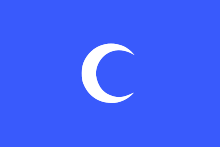 Flag of the Chehab Emirate 1697 – 1842
Flag of the Chehab Emirate 1697 – 1842
Through history, Lebanon, or at least its region, had taken the flag of the people who occupied it (Mamluk, Ottoman Empire)
French Mandate of Lebanon
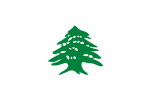 Flag of Lebanon after the fall of the Ottoman empire (1918–1920)
Flag of Lebanon after the fall of the Ottoman empire (1918–1920).svg.png) Flag of the State of Greater Lebanon during the French mandate (1920–1943)
Flag of the State of Greater Lebanon during the French mandate (1920–1943) Flag of the State of Greater Lebanon during the French mandate 1920–1943 (Variant)
Flag of the State of Greater Lebanon during the French mandate 1920–1943 (Variant) Flag of the State of Greater Lebanon during the French mandate 1920–1943 (Variant)
Flag of the State of Greater Lebanon during the French mandate 1920–1943 (Variant)
During the French Mandate of Lebanon, the Lebanese flag was designed by the president of the Lebanese Renaissance Movement, the late Naoum Mokarzel. It was similar to the tricolour flag of France but with a green cedar (Lebanon Cedar) in the middle.
Lebanese Republic
The present Lebanese flag was adopted just prior to independence from France in 1943. Seeking independence, the actual flag was first drawn by member of parliament Henri Pharaon[8][9] in the Chamber of deputies Saeb Salam's house in Mousaitbeh by the deputies of the Lebanese parliament. It was adopted on December 7, 1943, during a meeting in the parliament, where the article 5 in the Lebanese constitution was modified.
One theory is that since Henri Pharaon was a long-time consul in Vienna, Austria and was an avid friend and founder of the "Austro-Lebanese Association of Friendship", the colors could have been inspired by the red-white-red Flag of Austria, where the flag colors are based on the Lebanese geography and therefore, the first red represents the Mount Lebanon and the second red represents the Anti-Lebanon mountains and the white represents the Beqaa Valley, which is situated in the middle of the two mountain ranges on the map of Lebanon. And the green cedar (Lebanon Cedar) in the middle of the white part touches each of the red stripes is added because Lebanon is sometimes metonymically referred to as the Land of the Cedars.[10][11] The Austrian flag is the second oldest in the world, dating to the 13th century when it first probably appeared after the Siege of Acre during the Third Crusade. The colors could have been inspired by the red-white-red Flag of Austria, but the white stripe (a Spanish fess) could have been inspired by the red-yellow-red Flag of Spain, where the flag structure is based on the Lebanese connection to the Mediterranean sea and its Phoenician past that reached to the Mediterranean shores of present-day Spain.
Variant flags of Lebanon
The following is a list of variant flags used in Lebanon
 Design stored at WIPO
Design stored at WIPO- Flag as drawn and approved by the members of the parliament during the declaration of independence in 1943
 Flag used in the post World War I under the Arab Administration 1918–1920
Flag used in the post World War I under the Arab Administration 1918–1920 Flag used in Deir El Qamar, Capital of the Maanid and early Chehab emirs 1830
Flag used in Deir El Qamar, Capital of the Maanid and early Chehab emirs 1830 Rebels Flag during the Merdai era (Yemenites)
Rebels Flag during the Merdai era (Yemenites) National Maanid Flag
National Maanid Flag Rebels' Flag during Prince Ibrahim Era[7]
Rebels' Flag during Prince Ibrahim Era[7]
Official Lebanese flags from 1918-present
 Flag of the region of Lebanon after the fall of the Ottoman empire (1918–1920)
Flag of the region of Lebanon after the fall of the Ottoman empire (1918–1920).svg.png) Flag of the State of Greater Lebanon during the French mandate (1920–1943)
Flag of the State of Greater Lebanon during the French mandate (1920–1943) Flag of Republic of Lebanon (1943–present)
Flag of Republic of Lebanon (1943–present)
Similar design flags
The following are flags with similar design to the Lebanese flag:

.svg.png) Variant flag of Austria
Variant flag of Austria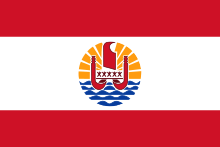




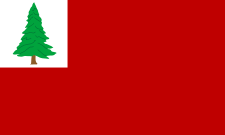 The Flag of New England during the Revolutionary War.[12]
The Flag of New England during the Revolutionary War.[12]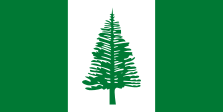
See also
Notes
- ↑ The description of the flag is cited in the Lebanese Constitution, Chapter 1, Article 5.
- ↑ "The Bible". Retrieved October 27, 2014.
- ↑ "The Bible". Retrieved October 27, 2014.
- ↑ "Firdaous - Arab world". Retrieved September 2, 2013.
- 1 2 "L'Orient-Le Jour". Retrieved October 27, 2014.
- ↑ "Ministry of information". Retrieved October 27, 2014.
- 1 2 3
- ↑ "Henry Pharoun Is Slain at Home; Founder of Free Lebanon Was 92". The New York Times. 1993-08-07. Retrieved 2008-10-08.
- ↑ "Lubnān, Republic of Lebanon, Al-Jumhūriyyah al-Lubnāniyyah". Flags of The World. CRW. Retrieved 2009-08-08.
- ↑ Budge, E.A.W. (2010). The Literature of the Ancient Egyptians. HardPress. p. 261.
- ↑ Cromer, G. (2004). A war of words: political violence and public debate in Israel. Cass series on political violence. Frank Cass. ISBN 978-0-7146-5631-1.
- ↑ "New England flags (U.S.)". Crwflags.com. Retrieved 2008-11-07.
External links
| Wikimedia Commons has media related to Flags of Lebanon. |
- Lebanon at Flags of the World
- Lebanese Flag Accurate, high quality, & high resolution flags of Lebanon.
